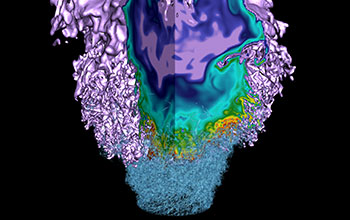Multimedia Gallery
Low-swirl Burner for Turbines and Furnaces (Image 2)
Close-up of a still from a simulation produced during a study on lean, hydrogen-air mixtures showing a cutaway profile of the concentration of hydroxyl molecules (that are produced and consumed at the flame). Red areas mark regions of intense combustion; fine gray-blue vortex structures at the base of the flame mark turbulence.
Combustion produces over 80 percent of the nation's energy, but also a large percent of air pollutants. Robert Cheng and colleagues at Lawrence Berkeley National Laboratory (LBNL) developed a low-swirl burner for turbines and furnaces. Requiring no pilot light or moving parts, it is a nozzle fitted to the end of a fuel pipe. Inside the nozzle, airfoil-like vanes make the flow of fuel swirl and expand radially as it exits the pipe, creating a local stagnation region where a bowl-shaped flame can sit indefinitely. If enough swirl is added to hold the flame steady, while not trapping any hot combustion products in a recirculation above the flame, it can burn lean with ultralow emissions. This simulation was created by LBNL's Center for Computational Sciences and Engineering and the National Energy Research Scientific Computing Center. (Date of Image: 2010) [See related image Here.]
Credit: Lawrence Berkeley National Laboratory
Images and other media in the National Science Foundation Multimedia Gallery are available for use in print and electronic material by NSF employees, members of the media, university staff, teachers and the general public. All media in the gallery are intended for personal, educational and nonprofit/non-commercial use only.
Images credited to the National Science Foundation, a federal agency, are in the public domain. The images were created by employees of the United States Government as part of their official duties or prepared by contractors as "works for hire" for NSF. You may freely use NSF-credited images and, at your discretion, credit NSF with a "Courtesy: National Science Foundation" notation.
Additional information about general usage can be found in Conditions.
Also Available:
Download the high-resolution JPG version of the image. (6.1 MB)
Use your mouse to right-click (Mac users may need to Ctrl-click) the link above and choose the option that will save the file or target to your computer.

